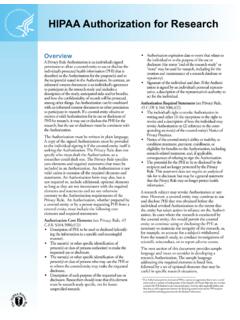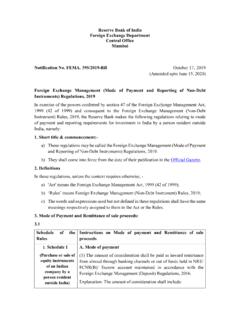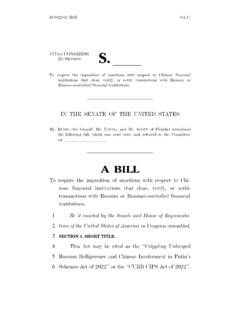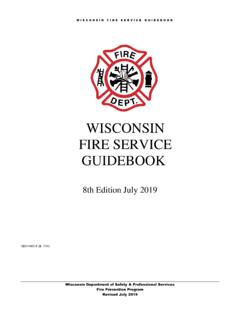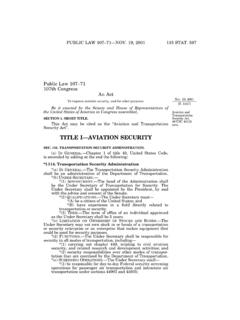Transcription of Clinical Research and the HIPAA Privacy Rule
1 Clinical Research and the HIPAA Privacy Rule Overview Researchers who conduct interventional Clinical Research have questioned how the Privacy Rule will affect their Research activities. Even before the Privacy Rule, of course, physician-investigators have been concerned about the Privacy of the medical and Research -related information of their patients and subjects. In fact, many have been required under the Department of Health and Human Services (HHS) or the Food and Drug Administration (FDA) Protection of Human Subjects Regulations (45 CFR part 46 or 21 CFR parts 50 and 56, respectively) to take measures to protect such personal health information from inappropriate use or disclosure. Mor eover, in Clinical Research , physician-investiga tors often stand in dual roles to the subject: As a treating physician and as a researcher.
2 For the treating physician, duties of confidentiality have long been established under well-known legal and ethical standards. The Privacy Rule adds to these existing obligations. Where a covered entity conducts Clinical Research involving protected health information (PHI), physician-investigators need to understand the Privacy Rule s restrictions on the use and disclosure of PHI for Research purposes. As the Federal Privacy standards are implemented throughout the country, one benefit is that many Clinical researchers and hospitals may adhere to a common set of national standards for protecting the Privacy of patients and Clinical Research subjects. This fact sheet discusses the Privacy Rule and its impact on covered entities that conduct Clinical Research .
3 It places specific emphasis on the Authorization that is generally required for Research uses and disclosures of PHI by covered entities. Additional information about the Privacy Rule s potential impact on other Research activi ties, such as repositories, databases, health services Research , Institutional Review Boards (IRBs), and Privacy Boards can be found in related publica tions, including: Protecting Personal Health Information in Research : Understanding the HIPAA Privacy Rule Health Services Research and the HIPAA Privacy Rule Research Repositories, Databases, and the HIPAA Privacy Rule Institutional Review Boards and the HIPAA Privacy Rule Priv acy Boards and the HIPAA Privacy Rule Introduction to the Privacy Rule In response to a congressional mandate in the Health Insurance Por tability and Accountability Act of 1996 ( HIPAA ), HHS issued regulations entitled Standards for Privacy of Individually Identifiable Health Information.
4 For most covered entities, compliance with these regulations, known as the Privacy Rule, was required as of April 14, 2003. The Privacy Rule is a response to public concern over potential abuses of the Privacy of health information. The Privacy Rule establishes a category of health information, referred to as PHI, which may be used or disclosed to others only in certain circumstances or under certain conditions. PHI is a subset of what is termed individually identifiable health information. With certain exceptions, the Privacy Rule applies to individu ally identifiable health information created or maintained by a covered entity. Covered entities are health plans, health care clearinghouses, and health care providers that transmit health infor mation electronically in connection with certain defined HIPAA transactions, such as claims or eligibility inquiries.
5 Researchers are not themselves covered entities, unless they are also health care providers and engage in any of the covered electronic transactions. If, however, researchers are employees or other workforce members of a covered entity ( , a hospital or health insurer), they may have to comply with that entity s HIPAA Privacy policies and procedures. Researchers who are not themselves covered entities, or who are not workforce members of covered entities, may be indirectly affected by the Privacy Rule if covered entities supply their data. In addition, it should be noted that the HHS and FDA s Protection of Human Subjects Regulations (45 CFR part 46 and 21 CFR parts 50 and 56, respectively) may also apply to Clinical Research .
6 Overview of the PrivacyRule s Impact on Clinical Research PHI includes what physicians and other health care professionals typically regard as a patient s personal health information, such as information in a patient s medical chart or a patient s test results, as well as an individual s billing informa tion for medical services rendered, when that information is held or transmitted by a covered entity. PHI also includes identifiable health information about subjects of Clinical Research gathered by a researcher who is a covered health care provider. The Privacy Rule permits a covered entity to use or disclose PHI for Research under the following circumstances and conditions: If the subject of the PHI has granted specific written permission through an Authorization that satisfies section For reviews preparatory to Research with representations obtained from the researcher that satisfy section (i)(1)(ii) of the Privacy Rule For Research solely on decedents information with certain representations and, if requested, documentation obtained from the researcher that satisfies section (i)(1)(iii) of the Privacy Rule If the covered entity receives appropriate documentation that an IRB or a Privacy Board has granted a waiver of the Authorization requirement that satisfies section (i)
7 If the covered entity obtains documentation of an IRB or Privacy Board s alteration of the Authorization requirement as well as the altered Authorization from the individual If the PHI has been de-identified in accordance with the standards set by the Privacy Rule at section (a)-(c) (in which case, the health information is no longer PHI) If the information is released in the form of a limited data set, with certain identifiers re-moved and with a data use agreement between the researcher and the covered entity, as specified under section (e) Under a grandfathered informed consent of the individual to participate in the Research , an IRB waiver of such informed consent, or Authorization or other express legal permission to use or disclose the information for Research as specified under the transition provisions of the Privacy Rule at section (c) Note that the Privacy Rule also permits covered entities to use and disclose PHI for purposes of treatment, payment, and health care operations without Authorization.
8 The Privacy Rule also permits disclosures to business associates. Business associates are persons or entities that perform certain functions or services on behalf of the covered entity that require the use or disclosure of PHI, provided certain arrangements to safeguard the PHI are in place between the covered entity and the business associates. The Privacy Rule also permits, without Authorization, covered entities to make a number of other disclosures of PHI, including disclosures that are required by law, disclosures to public health authorities authorized by law to collect or receive such information for public health activities, and disclosures for adverse event reporting to certain persons subject to the jurisdiction of the FDA ( , Clinical trial drug sponsors).
9 (See section for a description of other disclosures for which Authorization is not required.) For a more detailed discussion of permitted uses or disclosures of PHI for Research under the Privacy Rule, refer to Protecting Personal Health Information in Research : Understanding the HIPAA Privacy Rule; Research Repositories, Databases, and the HIPAA Privacy Rule; Institutional Review Boards and the HIPAA Privacy Rule; and Priv acy Boards and the HIPAA Privacy Rule. Authorization for PHI Uses and Disclosures A valid Privacy Rule Authorization is an individual s signed permission that allows a 2 covered entity to use or disclose the individual s PHI for the purpose(s) and to the recipient(s) stated in the Authorization. When an Authoriza tion is obtained for Research purposes, the Privacy Rule requires that it pertain only to a specific Research study, not to future, unspecified projects.
10 If an Authorization for Research is obtained, a covered entity s uses and disclosures must be consistent with what is stated in the Authorization. An Authorization differs from an informed consent in that an Authorization is an individual s permis sion for a covered entity to use or disclose PHI for a certain purpose, such as a Research study. An informed consent, on the other hand, is the individual s permission to participate in the Research . An informed consent provides Research subjects with a description of the study and of its anticipated risks and/or benefits, and a description of how the confidentiality of records will be protected, among other things. An Authorization can be combined with an informed consent document or other permission to participate in Research .
